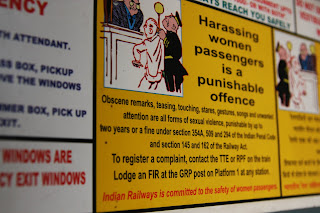
Solo travel as a single woman in India requires the following armor - a thick skin, full body coverage, dark sunglasses, knowledge of a couple of choice Hindi swear words and the ability to dish out a slap in the face if required (when you are groped – and yes this does occur in tight confined spaces such as buses, or busy shopping centers).
Philosophically it requires one to view the perpetrators as psychologically delinquent mama’s boys instead of intimidating; otherwise it’s easy to feel like not venturing out alone.
In India, bar’s are not for women without a male escort. As recently as last year, a group of women in a straightforward Bangalore pub were dragged out by the “moral police” and beaten up for daring to be single women in a bar.
Simply put, the Indian male sexual psyche, regardless of age, remains profoundly regressive and stuck in the teenage years, a product of sexual repression and a system of morality distilled from a male superiority complex based on an archaic history of society prizing men (traditional breadwinners) over women. (determining the sex of the fetus is illegal in India for fear of high number of aborted female fetuses).
The practice of dedicating devadasi’s (temple “dancers”) in Karnataka to supplement family income amongst the poor is still practiced to this day. Pimps from Bombay’s red light district flock to these ceremonies to recruit pubescent girls to the trade.
What one would consider sexual harassment in the west is the norm and part of everyday life for women in India. A woman wearing anything other than the traditional Indian clothing of salwar kameez or a sari regardless of whether she is Indian or a foreigner will be ogled at lasciviously, curiously and disdainfully when outside the confines of her home. In discussing the matter with locals, even older conservative traditionally dressed women have been “eve teased” as they put it.
“Eve teasing encompasses the gamut of sexual harassment offences such as staring, groping, whistling, masturbating, singing songs etc
The increase in the severity of eve teasing probably began with the influx of unescorted females leaving their homes to answer the call for capable workers in the booming IT, BPO and call center industries in the 1990’s
Sexually repressed men everywhere took this as the perfect opportunity to inflict their teenage mentality on female travelers on buses and trains. As an answer to this social menace, the government created laws calling for the punishment of eve teasing through fines and imprisonment. Cities such as Bombay which have higher numbers of single female travelers have created “female only” trains during peak hours.
What does one do?
On a personal level, the best way to deal with this everyday menace has been to ignore the perpetrator (philosophically viewing them as pathetic and ignorant takes away the feeling of intimidation). Wearing dark sunglasses helps.
When the advances have encroached into my personal space (touching, accidental brushing, singing songs or even at one time masturbating – happened when I was checking out a park in Bombay) I have administered one of three treatments – depending on the set and setting:
- Getting up and walking away (singing)
- A tight slap across the face followed by choice Hindi swearword, or JAO (meaning go) when groped.
- Getting out my camera and telling the perpetrator that I am a reporter from the US and will take a photo of him for the police and US consulate and asked for his name at which point he ran off (probably to his mummy).
Resources such as project Blank noise are an excellent way to vent your frustrations or join the cause; they even have a list of photos of perpetrators, so if you catch your man in action do send it along. Check out http://blog.blanknoise.org/









